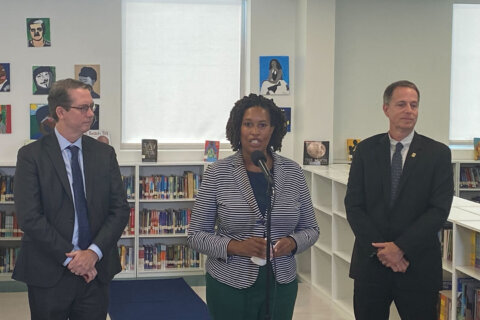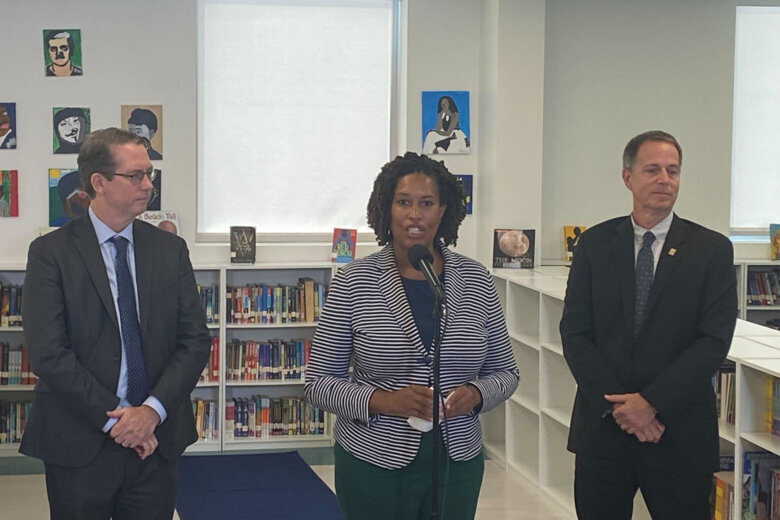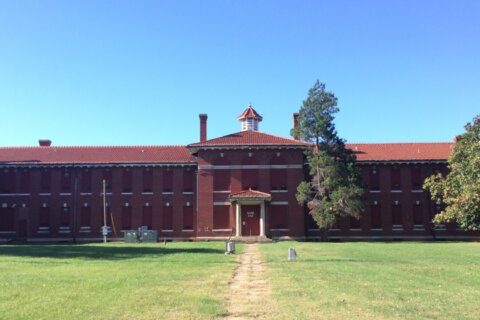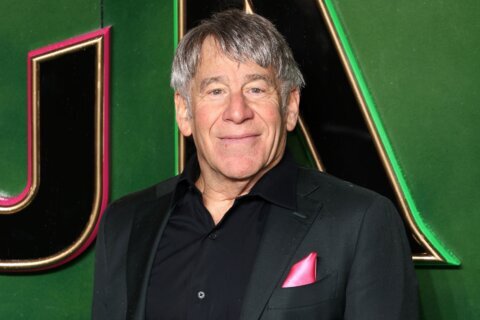
D.C. Mayor Muriel Bowser and other city leaders walked around the hallways, observed classes, and even partook in a dance class at KIPP DC Promise Academy in Southeast Monday, where kids were beginning their new school year two weeks before other Public Schools students in the District.
D.C. Deputy Mayor for Education Paul Kihn praised the “quiet halls, incredible instruction, and very, very importantly, wonderful teachers demonstrating truly magnificent instruction in every room that we visited,” at the end of the quick tour.
City Administrator Kevin Donahue said that since May 1, the Department of General Services had taken care of thousands of work orders, checking off 80% of the issues identified by the end of the previous school year. Donahue said that put the city ahead of where it usually is at this time.
In her opening remarks, the mayor reminded city residents and commuters to pay attention on the roads for kids waiting for buses or walking to school. She also praised city teachers, both at KIPP and throughout the city.
New teacher survey on school violence
Safety has also been on the mind of teachers too, though a statement from the city’s teachers union suggested it doesn’t see the same concern city leaders were voicing at KIPP.
A news release from the Washington Teachers Union President Jacqueline Pogue Lyons argued that city leaders had ignored safety recommendations made at a time when teachers are feeling less and less safe at work.
Calling the situation, described as the number one concern for teachers, “dire,” Lyon said a recent survey conducted by the union found 42% of D.C. teachers feel they’ve seen workplace violence increase a lot over the past year, while another 23% say it increased a little. Large numbers of teachers reported seeing violent interactions between students, as well as student-on-teacher violence.
According to the survey, what they’re seeing in schools is also impacting their mental health, with three out of four teachers saying the violence has caused them anxiety, fear, or increased vigilance at work. Nearly half of them said they had considered leaving the profession.
The survey was conducted over a one-month period in May, with responses from teachers and staff more than 100 DCPS schools, according to Lyons. When asked about it on Monday, city leaders were seemingly caught off-guard.
“That will literally be the first time I heard that from her,” said Bowser, after a reporter read directly from the survey. “So I’m very interested to hear what she’s asking for. And I’ll have that conversation with her.”
Pressed for a little more clarification, City Administrator Kevin Donahue said he had been made aware at the start of the summer that such a survey was being taken.
“She did commit in that conversation to talk with me about the results,” said Donahue. “This is the first time I’ve heard that she has results.”
But after the previous school year saw so many violent incidents occurring, not just in schools, but also near schools as kids were getting dismissed for the day, it was no surprise that public safety would be a topic for discussion.
On more than one occasion the mayor and her top deputies pressed the council to put school resource officers back in the classroom, while touting other programs aimed at reducing violence that impacts students.
“We’re extremely pleased that this year we’ve continued our commitment to Safe Passage/Safe Blocks,” said Kihn, talking about a program that puts 180 adults on the streets to supervise the arrival and departure of kids at more than 50 schools every day.
“So we work in eight of our most, we think, dangerous areas in the city. And we are continuing to push that work this year.
“Importantly, we’re also continuing our DC SchoolConnect program,” added Kihn. “This is a program that actually provides busing at a number of schools in Ward seven and eight where the students feel unsafe traveling to and from school.”
He also boasted about safety protocol training at public and private schools around the city, as well as greater emphasis on conflict resolution. But leaders also conceded that more help has to come from outside of the executive branch.
“I do think some of the changes in allowing for more SROs to come back in schools will be helpful,” said Donahue. “And really looking at how we handle, in school, some of the discipline challenges … recent laws that put into place that have tied the hands of what school leaders have options to do with regards to challenges within schools.”
And Bowser made clear that it would take more community effort to provide safer school environments too, telling kids around the city “to continue showing up at school, following positive adults and learning as much as they can every single day. Just like I tell my daughter, that’s your job,” said the mayor.
Then she addressed the adults around the city.
“Let’s let these kids be kids,” pleaded the mayor. “Their potential is just … it’s just expansive. And we owe it to them as adults to make sure that all the systems that support them work. That the families that they’re a part of work, and that our communities work.”
“So I want the kids to be kids, listen to the adults and learn as much as they can. And to be excited as I am about the first day of school,” Bowser added.









